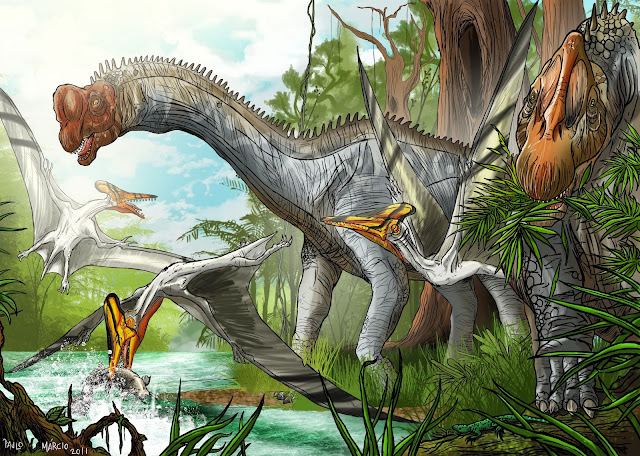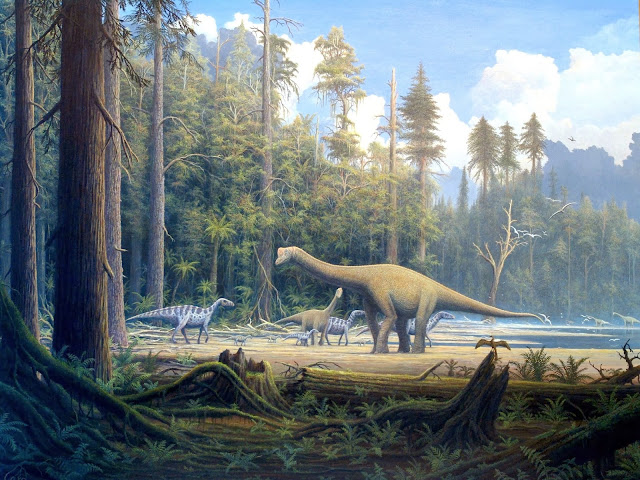 |
| ©Karkemish (via Deviantart) |
↧
Blank Faced Ornithopods
↧
Atlascopcosaurus and Little Fact Pages
Atlascopcosaurus shows its face rarely if at all in terms of reliable internet sites. This is not much different from the types of things that exist to present on normal Sundays; in a perfect world there would be far more sources for every animal for younger readers. However, today the only quality links, and thankfully they are quality links that happen to exist, come to us from About and the NHM in London. I also took the liberty of clearing out a rather blank image to begin with for coloring purposes.
↧
↧
Australia in Motion
Atlascopcosaurus is not a vividly in motion Australian dinosaur. There are few resources that show Atlascopcosaurus in motion adequately but there is a tribute video, and that is a step in at least a somewhat progressive direction. Beyond that there really is not much in the way of videos. Below is the tribute video that shows Atlascopcosaurus, however briefly it is; it is a video highlighting all Australian dinosaurs afterall.
↧
A Book Star
Atlascopcosaurus has not made a significant impact, overall, in the peer reviewed scientific publication world. It has, however, appeared in a number of books as passing information and even as a key character. Some of these books may have been mentioned in prior entries given that they have information contained with that discusses other Australian dinosaurs. These include books like Minmi and Other Dinosaurs of Australia as well as World's Smallest Dinosaurs. Rich and Vickers-Rich published the initial naming and describing paper, as previously stated, but they also co-wrote a 1999 paper which was much more about the Hypsilophidontids of Australia as a whole; the abstract can be found through this link. Chapter 18 of Dinosaur Systematics describes the basal Ornithopoda and here too Atlascopcosaurus is touched upon. The Witmer Lab at Ohio University hosts a PDF version of this chapter, making it available online; Dr. Witmer is a co-author of the chapter.
↧
Once A Hypsilophodont
 |
| ©Robinson Kunz |
↧
↧
Exciting Times!
There is little to discuss in terms of the popular culture impact of our small basal Ornithopoda friend Atlascopcosaurus this week. As such, we will discuss the world in which this dinosaur lived. Atlascopcosaurus was discovered in Dinosaur Cove's Eastern area in 1984. 104 million years ago the Dinosaur Cove area was closely associated, geographically, with the landmass of Antarctica and well below the Antarctic Circle. Current research indicates that the areas within the southernmost area of the globe near the Antarctic Circle potentially occurred dark and light seasons. More famous denizens of this light and dark season land include Muttaburrasaurus (the taxon in which Atlascopcosaurus is sometimes considered a member due to its fragmentary nature), Leaellynasaura, and even a carnivore simply referred to most often as Dwarf Allosaurus. It is unfortunate that more of this little dinosaur has not been recovered (and also that it actually be a nomen dubium that belongs to another species). Regardless, the adaptations to light and dark seasons that could potentially be seen in this taxon would be wonderful. Should more ever be discovered it will tell us a lot about the dinosaur and it will definitively answer the question regarding the position of the dinosaur itself.
↧
So Small I Missed It All This Time
 |
| I've seen this before, but I cannot make out the illustrator's name. |
Granted the above quote is in reference to the novel's Procompsognathus denizens and we are covering their descendant, Compsognathus, it is still a wonderful little quote from the novel about a somewhat understated lineage of dinosaurs. Both Procompsognathus and Compsognathus were small theropod dinosaurs with "elegant jaws" (the meaning of Compsognathus). Compsognathus consists of a single species, C. longipes, though a now synonymous species was once purported to exist as well (C. corallestris). The originally described size was slightly smaller than the full grown adult size of just over a meter or about 3.3ft. The reason for this is that a juvenile specimen was initially described as an adult. Regardless, at approximately a meter long and between 1.8 and 7.7lb (0.83 and 3.5kg) Compsognathus was the smallest non-avian dinosaur known for many years. An obligate biped, Compsognathus was quite gracile and agile, able, more than likely, to chase down many smaller prey items like large insects and small mammals and lizards. Though often depicted (in Jurassic Park related media primarily) as pack hunters, no evidence of this behavior exists that has been documented. Feather coverings, though not depicted often, may have been present on living members of the species, as they are closely related to known feathered dinosaurs such as Sinosauropteryx and Sinocalliopteryx.
↧
Staring Pretty
 |
| ©NRG (a good fellow from Argentina) |
 |
| ©Nobu Tamura |
↧
Coloring and Learning
 |
| ©Emily Sheldon |
↧
↧
Compy Puppets!
I am going to let the videos do the talking today. There is a puppet video as well as the I'm A Dinosaur version for Compsognathus.
↧
All the Papers
 |
| ©Karola (Caimryo) |
↧
Grasping Hands For Grabbing You Up
 |
| ©Shelley Kornatz (Eykoart) |
↧
Turkey Day Tribute
Compsognathus is a good little dinosaur. It has been an interesting dinosaur to discuss and research. I wish to keep things short today as I have a lot of Thanksgiving related things to do and so too does the American audience. However, Compsognathus is so popular in popular culture that I feel it is of great importance that I need to share the above Spore creature, a plush dinosaur from a friendly Finnish artist , and this wonderful image of what a turkey wing could look like if it came off of Compsognathus or another theropod:
↧
↧
Big Nostril Lizard Foot
| Picture by Nils Knötschke |
↧
Looking at Europa
 |
| ©Paulo Marcio |
 |
| ©Andrey Atuchin |
↧
German Resources
We have good English resources today from the London NHM as well as National Geographic making Europasaurus an international star for children. The home state, Germany of course, also gets in on the Europasaurus fun in the Dinosaur Park of Rehburg-Loccum in the Neinburg district of central Germany. The park hosted an art contest for Europasaurus not too long ago. One of the results of this was some art that can be used as a coloring page:
↧
Europasaurus Time Lapse
I found two videos that are time lapsed and pretty interesting. The first is of a painting of Europasaurus which is fantastic.
The second video is a time lapse of the preparations of a Europasaurus fossil.↧
↧
Reading A Lot About A Little
 |
| ©Nobu Tamura |
Europasaurus, for all of its small stature, is a fairly widely read dinosaur; meaning that people write about it quite often and it is therefore read about globally, not that the dinosaur itself read a lot of literature. An article in Systematic Paleontology discusses the postcranial axial skeleton of Europasaurus in a fair amount of detail, if you can get a copy of it for yourself. Old news articles are usually a welcome source of information as well. This Geotimes article discusses the "newly discovered"Europasaurus and gives the small dinosaur a short but emphatic introduction to the world via a non-peer reviewed entry into the literature of the world without being too sensationalist; as the media has a tendency to do with dinosaur news. I typically dislike posting a search result, it happens from time to time, but there are a few pdf's in the search for Europasaurus that cannot be linked as they open directly from the search. I recommend Sander et al.'s supplementary information (Geology and taphonomy of the Langenberg quarry locality) and at least inspecting the abstract of Bolecsek and Wings here (Europasaurus holgeri–the dwarfed dinosaur from the Late Jurassic of Germany).
↧
Shrink Wrapped
 |
| ©Gerhard Boeggemann (His site is not working lately, so it is not linked) |
↧
Popularity Island
 |
| ©Cheung Chung Tat |
↧





